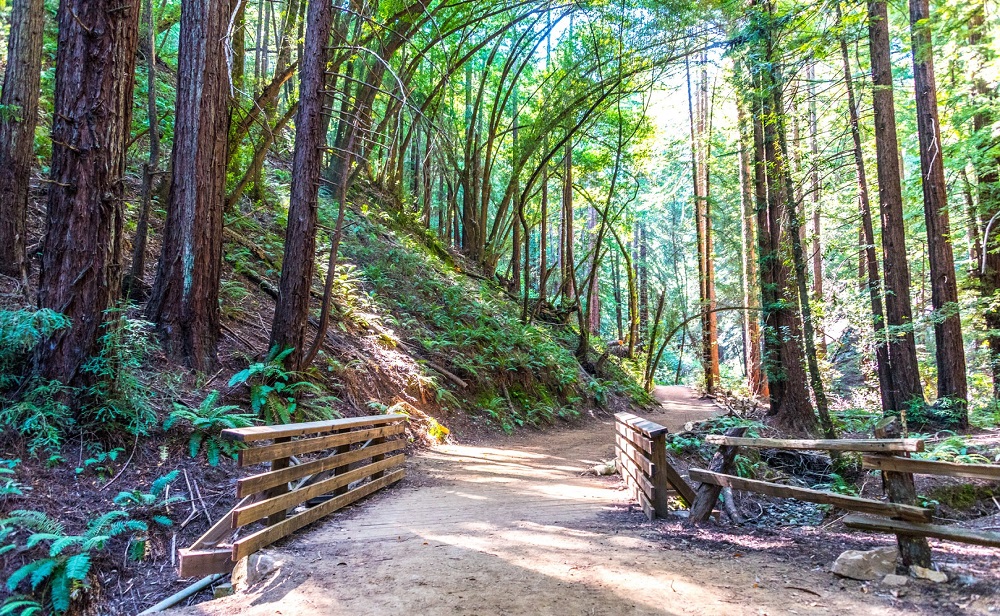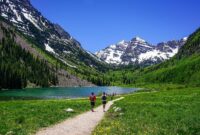Nice Trails Near Me: Discovering the perfect outdoor escape starts with knowing where to look. This guide explores how to locate, evaluate, and enjoy nearby trails, catering to various activity levels and preferences. We’ll delve into the characteristics that define a “nice” trail, from scenic overlooks to well-maintained paths, and provide practical tips for planning a safe and rewarding adventure.
Whether you’re a seasoned hiker, a casual biker, or a passionate runner, finding the ideal trail requires careful consideration of factors like difficulty, accessibility, and surrounding scenery. This guide equips you with the knowledge and resources to find your perfect outdoor escape, ensuring a memorable experience.
Defining “Nice Trails”
The definition of a “nice” trail is highly subjective and depends heavily on the user’s preferences and the activity they intend to pursue. A trail considered ideal for a seasoned mountain biker might be far too challenging for a casual hiker, and vice versa. Factors such as scenery, difficulty level, accessibility, and trail maintenance all contribute to the overall experience and determine whether a trail is deemed “nice.”
Trail Characteristics and Enjoyment Factors
Trail Characteristics for Different User Groups
Different user groups have varying expectations for a “nice” trail. Hikers often prioritize scenic views, well-maintained paths, and manageable elevation changes. Bikers, on the other hand, may seek more challenging terrain with exciting features like berms, jumps, and flowy sections. Runners typically look for smooth surfaces, well-marked routes, and a good balance of elevation gain and loss. The ideal trail is thus intrinsically linked to the intended activity.
Factors Influencing Trail Enjoyment
Several factors significantly impact the enjoyment of a trail. Scenery plays a crucial role; trails with stunning vistas, lush forests, or interesting geological formations are generally more appealing. The difficulty level is another key factor, with some users preferring challenging climbs and technical sections while others prefer easier, more accessible routes. Accessibility is also vital, particularly for users with mobility limitations; features like wide, well-graded paths and accessible parking are essential for inclusivity. Finally, well-maintained paths, free of obstacles and hazards, enhance safety and enjoyment.
Trail Features Enhancing User Experience
Many features can significantly improve the trail experience. Well-maintained paths are crucial for safety and comfort, reducing the risk of injuries and ensuring a smooth journey. Scenic overlooks provide breathtaking views, creating memorable moments for users. Shaded areas offer respite from the sun on hot days, increasing comfort and enjoyment, especially during peak hours. Clear signage and trail markers aid navigation, reducing the risk of getting lost. Rest areas or benches provide opportunities for rest and relaxation along the trail. Finally, the availability of amenities such as water fountains or restrooms can enhance the overall experience.
Comparison of Trail Types and Ideal Characteristics
| Trail Type | Ideal Surface | Preferred Difficulty | Desirable Features |
|---|---|---|---|
| Hiking | Natural, well-maintained paths; potentially some rocky sections | Variable, ranging from easy to strenuous | Scenic overlooks, shaded areas, clear signage, benches |
| Biking | Smooth, flowing trails with berms and jumps (for mountain biking); paved paths (for road biking) | Variable, from beginner-friendly to highly technical | Flowy sections, challenging climbs and descents, well-maintained surfaces, minimal obstacles |
| Running | Smooth, relatively even surfaces; ideally, a mix of hard-packed dirt and paved sections | Variable, from easy to strenuous; often involving loops for varying distances | Well-marked routes, minimal obstacles, scenic views, easily accessible water sources |
Locating Nearby Trails
Finding enjoyable trails near you is easier than ever thanks to the proliferation of online resources. These tools offer various ways to discover trails based on your location, desired difficulty, length, and type of terrain. Effectively utilizing these resources requires understanding their strengths and limitations.
Locating nearby trails involves leveraging several digital tools, each with its unique features and data sources. These platforms range from general-purpose mapping applications to specialized trail databases. Understanding how to use these tools effectively can significantly enhance your trail-finding experience.
Utilizing Online Mapping Applications and Trail Databases
Many popular mapping applications, such as Google Maps, Apple Maps, and others, include trail information. These applications often leverage user-submitted data, which can be both a strength and a weakness. Their strengths lie in their widespread availability and integration with other navigation features. However, the accuracy and completeness of user-submitted trail data can vary considerably. Dedicated trail databases, such as AllTrails or Trailforks (examples, not endorsements), often offer more detailed trail information, including elevation profiles, reviews, and photos submitted by users. These specialized platforms focus specifically on trails, leading to a more comprehensive and reliable dataset than general-purpose mapping applications.
Examples of Trail Map Types and Their Characteristics
Different trail maps present information in various ways, each with its advantages and disadvantages. Topographic maps, for instance, show elevation changes and terrain features, providing crucial information for assessing trail difficulty. However, they can be complex for novice users. Simple line maps display only the trail’s route, making them easy to understand but lacking detailed terrain information. Satellite imagery overlaid with trail routes offers a visual representation of the trail environment, but might not clearly show subtle elevation changes or trail conditions. Hybrid maps often combine elements of these different map types, aiming to provide a balanced approach.
Comparative Analysis of Online Trail Platforms
Different online platforms vary in the type and quality of information provided. Some platforms might excel in user reviews and photos, while others prioritize detailed elevation profiles or trail difficulty ratings. For example, AllTrails is known for its extensive user reviews and photos, while Trailforks focuses more on mountain biking trails and includes features like trail conditions and difficulty ratings specific to that activity. Google Maps might offer a broader view, incorporating trails alongside other points of interest, but its trail-specific data may be less comprehensive than dedicated trail databases.
Criteria for Evaluating Trail Information Reliability
Evaluating the reliability of trail information sources requires a critical approach. Several key criteria should be considered. These include the source of the data (user-submitted versus professionally surveyed), the frequency of updates, the availability of multiple data points (e.g., multiple user reviews), and the presence of clear disclaimers about potential inaccuracies. Cross-referencing information from multiple sources can further enhance confidence in the accuracy of the trail information. Looking for consistency in reported trail lengths, elevation gains, and difficulty ratings across different platforms is also a good practice.
Trail Information and Safety
Prioritizing safety and preparedness is paramount when exploring local trails. Understanding trail conditions and potential hazards significantly reduces the risk of accidents and ensures a more enjoyable experience. Thorough planning and preparation are key to a successful and safe hike.
Checking trail conditions and weather forecasts before setting out is crucial for a safe and enjoyable hike. Unforeseen changes in weather, such as sudden downpours or unexpected temperature drops, can drastically impact trail conditions and create hazardous situations. Similarly, knowing about trail closures, recent maintenance work, or potential hazards like fallen trees or washed-out sections allows for informed decision-making and prevents unnecessary risks. Many online resources and local hiking groups provide up-to-date information on trail conditions.
Essential Hiking Gear
Carrying a well-stocked pack with essential items is fundamental to safe trail exploration. The specific items will vary depending on the trail length, difficulty, and weather conditions, but a basic checklist is crucial for preparedness.
- Appropriate footwear: Sturdy hiking boots or trail shoes with good ankle support are essential to prevent injuries.
- Sufficient water: Carry more water than you think you’ll need, especially during hot weather or longer hikes. Dehydration is a serious risk.
- First-aid kit: A comprehensive kit should include bandages, antiseptic wipes, pain relievers, and any personal medications.
- Map and compass/GPS device: Knowing how to navigate using a map and compass, or a GPS device, is vital in case of getting lost. Familiarity with these tools is essential before heading out on less-traveled trails.
- Sunscreen and insect repellent: Protect your skin from the sun and insect bites, especially during warmer months.
- Extra layers of clothing: Weather conditions can change rapidly, so packing extra layers to adapt to temperature fluctuations is important.
- Headlamp or flashlight: Essential for navigating in low-light conditions or unexpected delays.
- Emergency whistle: A whistle can be used to signal for help in case of an emergency.
- High-energy snacks: Trail mix, energy bars, or other easily consumed snacks can provide necessary energy during the hike.
Safe Trail Navigation
Navigating trails safely requires a combination of planning and awareness. Using appropriate tools and employing sound judgment are key components.
Before embarking on a hike, thoroughly study a trail map, noting key landmarks, junctions, and potential hazards. Knowing the trail’s length, elevation gain, and estimated hiking time allows for better time management and reduces the risk of getting caught out in poor weather conditions. If using a GPS device, ensure it is fully charged and you know how to operate it effectively. For less-traveled trails, a compass and map are invaluable tools for navigation, requiring practice to use correctly.
Trail Hazards and Safety Measures
Understanding potential trail hazards and implementing appropriate safety measures is critical for minimizing risk. This proactive approach ensures a safer and more enjoyable hiking experience.
| Potential Hazard | Recommended Safety Measure | Example | Additional Notes |
|---|---|---|---|
| Slippery rocks and trails | Wear appropriate footwear with good traction; use trekking poles for added stability; proceed cautiously. | Wet rocks after rainfall. | Avoid hiking on slippery surfaces if possible. |
| Wildlife encounters | Make noise while hiking to avoid surprising animals; carry bear spray (if applicable); maintain a safe distance from animals; never feed wildlife. | Encountering a bear or deer on the trail. | Learn about local wildlife and their behavior before your hike. |
| Getting lost | Carry a map and compass/GPS; plan your route beforehand; stay on marked trails; inform someone of your hiking plan. | Wandering off trail in unfamiliar territory. | Regularly check your location against your map. |
| Sudden weather changes | Check the weather forecast before your hike; dress in layers; carry rain gear; be prepared to turn back if conditions deteriorate. | Unexpected thunderstorm during a hike. | Monitor weather conditions throughout your hike. |
Trail Descriptions and Reviews
This section delves into the art of crafting compelling trail descriptions and showcases examples of user reviews that effectively capture the essence of a hiking experience. We’ll examine different writing styles and highlight key elements that make a description both informative and engaging.
Detailed Trail Descriptions
Effective trail descriptions go beyond simply listing the distance and elevation gain. They aim to transport the reader to the trail, allowing them to visualize the scenery, imagine the terrain, and anticipate the experience. A successful description should evoke emotion and build anticipation.
- Whispering Pines Trail: A moderately challenging 5-mile loop trail through a dense pine forest. The trail features gentle inclines and declines, with several rocky sections that require careful footing. Hikers can expect stunning views of the valley below from various overlooks along the route. The trail is relatively shaded, making it ideal for hiking on warmer days. Wildflowers bloom profusely in the spring, adding a splash of color to the already picturesque setting. Expect to encounter various species of birds and perhaps even a deer or two.
- Summit Ridge Trail: This strenuous 8-mile out-and-back trail offers breathtaking panoramic views from its summit. The trail is steep and rocky in sections, demanding a good level of fitness. Hikers should be prepared for exposed sections with limited shade, particularly during the midday sun. The reward for the effort is unparalleled: a 360-degree vista of rolling hills, sparkling lakes, and distant mountain ranges. This trail is best suited for experienced hikers.
- Riverbend Trail: A leisurely 2-mile loop trail following the banks of a crystal-clear river. The trail is relatively flat and easy to navigate, making it perfect for families and casual hikers. Hikers can enjoy the soothing sounds of the river and the opportunity to spot various wildlife along the way, including ducks, herons, and possibly even otters. The trail is mostly shaded, offering respite from the sun. Picnic spots are plentiful along the riverbank.
Sample User Reviews
User reviews provide valuable insights into the trail experience, offering a diverse perspective that complements the formal trail description. Authentic and detailed reviews enhance the credibility and appeal of the trail information.
- Whispering Pines Trail Review: “Absolutely loved this trail! The scenery was stunning, especially the wildflowers in the spring. A few challenging spots, but overall a great moderate hike. Highly recommend!” – Sarah J.
- Summit Ridge Trail Review: “This was a tough one, but the views from the top were worth every drop of sweat! Bring plenty of water and wear sturdy shoes. Definitely a rewarding hike for experienced hikers.” – Mark L.
- Riverbend Trail Review: “Perfect for a relaxing afternoon stroll. The river was beautiful, and we even saw a family of ducks! Easy enough for my young children to handle.” – Emily K.
Comparative Analysis of Trail Description Styles
Different writing styles can be employed to create compelling trail descriptions. A descriptive style focuses on vivid imagery and sensory details, painting a picture in the reader’s mind. A factual style prioritizes accurate information and objective details, providing a comprehensive overview of the trail’s features. A narrative style tells a story, engaging the reader with a personal account of the trail experience. The most effective descriptions often blend these approaches, incorporating both factual information and evocative language. For example, a factual description might highlight the trail’s length and elevation gain, while a descriptive passage could capture the beauty of a sunset over a mountain range.
Visual Representation of Trails
A compelling visual representation of a trail is crucial for attracting hikers and showcasing its unique appeal. Effective photography can translate the experience of walking the trail, conveying the beauty of the surroundings and the character of the path itself. This involves careful consideration of several key photographic elements.
Effective Photographic Elements for Trail Representation
Lighting, Composition, and Perspective in Trail Photography
Lighting dramatically alters the mood and visual impact of a trail photograph. Soft, diffused light, such as that found during the golden hour (sunrise and sunset), often renders landscapes with a warm, inviting glow, enhancing colors and creating long shadows that add depth. Harsh midday sun, conversely, can lead to high contrast and washed-out colors, making details less visible. Composition, employing the rule of thirds or leading lines (like a winding trail itself), guides the viewer’s eye and creates a more engaging image. Perspective is equally important; a low angle can emphasize the scale of towering trees or mountains, while a high angle can provide a broader view of the trail’s surroundings and its overall context within the landscape.
Photographic Opportunities in Different Trail Environments
The photographic opportunities vary significantly depending on the trail environment.
Forest Trails: Forest trails offer a wealth of opportunities for evocative photography. The interplay of light filtering through the canopy creates dappled patterns on the forest floor, adding texture and interest. Focusing on details like moss-covered rocks, vibrant fungi, or the intricate patterns of tree bark can produce captivating close-up shots. Wider shots can capture the sense of depth and mystery within the forest, emphasizing the winding trail disappearing into the green depths. Consider using a slower shutter speed to blur the movement of leaves in the wind, adding a sense of tranquility.
Mountain Trails: Mountain trails provide dramatic backdrops for breathtaking photography. Panoramic views from mountain summits showcase expansive landscapes, capturing the scale and grandeur of the mountains. Close-up shots of wildflowers blooming amidst rugged terrain, or rocky outcrops with interesting textures, offer details that contrast with the vastness of the scenery. Capturing the interplay of light and shadow on the mountain slopes, especially during sunrise or sunset, can create stunning images. Consider using a polarizing filter to reduce glare and enhance the colors of the sky and mountains.
Desert Trails: Desert trails offer unique photographic challenges and rewards. The vast open spaces and stark landscapes provide a minimalist aesthetic. Focusing on the textures of sand dunes, the unique forms of desert plants (cacti, succulents), or the play of light and shadow on the arid landscape can create striking images. Capturing the vastness of the sky and the subtle color variations in the sand can create a sense of scale and isolation. Shooting during the cooler hours of the day can help avoid harsh shadows and improve color saturation. Using a wide-angle lens can capture the expansive nature of the desert landscape effectively.
Visual Representation of a Hypothetical Trail
Imagine a trail winding through a lush meadow nestled between rolling hills. The path, a gently curving ribbon of packed earth, is bordered by wildflowers in vibrant hues of purple, yellow, and orange. Sunlight streams through the gaps in the surrounding trees, dappling the meadow with light and shadow. In the distance, a majestic mountain range rises, its peaks capped with snow, providing a breathtaking backdrop. The overall image conveys a sense of serenity and adventure, inviting the viewer to explore this idyllic trail. The composition would utilize the rule of thirds, with the trail curving towards the mountain range in the background. The light would be soft and diffused, enhancing the colors of the wildflowers and the snow-capped peaks. The perspective would be from a slightly elevated position, providing a clear view of the trail and its surroundings.
Wrap-Up
Ultimately, discovering “nice trails near me” is a journey of exploration and personal preference. By utilizing the resources and strategies outlined in this guide, you can confidently embark on adventures that suit your skill level and desired experience. Remember to prioritize safety, respect the environment, and enjoy the beauty of the natural world around you. Happy trails!




